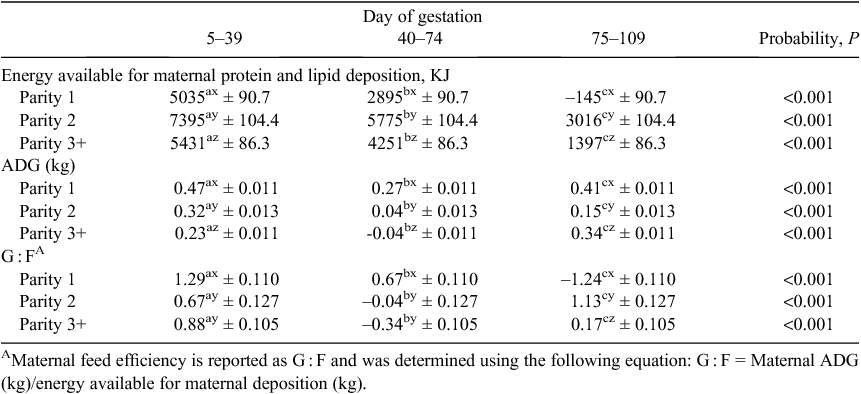Effect of parity and stage of gestation on maternal growth and feed efficiency of gestating sows
L. L. Thomas A C , R. D. Goodband A , M. D. Tokach A , J. C. Woodworth A , J. M. DeRouchey A and S. S. Dritz BA College of Agriculture, Kansas State University, Manhattan, KS 66506, USA.
B College of Veterinary Medicine, Kansas State University, Manhattan, KS 66506, USA.
C Corresponding author. Email: lorithomas@ksu.edu
Animal Production Science 57(12) 2471-2471 https://doi.org/10.1071/ANv57n12Ab138
Published: 20 November 2017
Previous research in regards to gestating sow nutrient requirements (Noblet et al. 1990) has been used to develop models based on the sow’s body condition, parity and stage of gestation. However, data are limited pertaining to the application of these models in current commercial sow herds to determine maternal growth and efficiency of feed usage of modern sows. Therefore, the objective of this study was to evaluate the effect of parity and stage of gestation on maternal weight gain and efficiency of feed use in gestating sows from a commercial sow farm. A total of 712 females were group-housed from d 5 to 112 of gestation and individually fed with electronic sow feeders (ESF). Feed intake and bodyweight (BW) were recorded daily throughout gestation. Gilts (Parity 1) and sows, received 27.2 and 30.5 MJ ME per d based on set feeding strategies. Gilts and sows received 2.0 and 2.3 kg per day throughout the course of gestation. Maternal weight gain, not including products of conceptus, and feed efficiency was predicted using a series of equations to model nutrient utilisation in gestation (Dourmad et al. 2008). Data were divided into three parity groups and gestation was divided into three periods. Averages for each period were reported for all predictions with the exception of G : F, where the median for each period was reported. Data were analysed using PROC MIXED procedure in SAS (v9.4, SAS Institute Inc., Cary, NC, USA).
Parity 2 sows had the greatest (P < 0.05) energy use for maternal protein and fat deposition in all stages of gestation while Parity 1 sows had a negative energy balance during the final stage of gestation (Table 1). At every stage of gestation, maternal gain decreased with parity (P < 0.05). Regardless of parity, maternal average daily gain (ADG) decreased (P < 0.05) from d 39 to 74 before increasing (P < 0.05) during the final stage of gestation. Parity 1 sows had the greatest (P < 0.05) maternal ADG in all gestation periods. Parity 1 sow maternal G : F decreased (P < 0.05) in each sequential period of gestation. Parity 1 sow G : F was greater (P < 0.05) than Parity 2 and 3+ sows in most gestation periods.

|
Overall, this study and subsequent prediction models show how stage of gestation and parity affect growth of different tissue pools, sow maternal BW, and feed usage throughout the course of gestation. Further research is needed to investigate these differences and if there is an impact on subsequent performance.
References
Dourmad JY, Etienne M, Valancogne A, van Miligan J, Noblet J (2008) Animal Feed Science and Technology 143, 372–386.| Crossref | GoogleScholarGoogle Scholar |
Noblet J, Dourmad JY, Etienne M (1990) Journal of Animal Science 68, 562–572.
| Crossref | GoogleScholarGoogle Scholar |
Appreciation is expressed to Thomas Livestock Co. (Broken Bow, NE) for providing the animals and research facilities.


